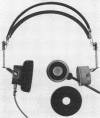Abstract
Noise-excluding earphones may be subdivided into circumaural earphones and noise-attenuating earphone enclosures. Two versions of `Otocups', an example of the latter subdivision, were evaluated in a series of experiments and in comparison with a conventional type of earphone (Telephonics TDH-39 receiver in a MX-41/AR cushion). The experiments involved a comparison of auditory threshold, artificial-ear measurements, test-retest reliability, and pure-tone attenuation. The second version of `Otocups' was considered sufficiently reliable for most purposes and to have practical applications in industrial and clinical audiometry when proper booths are not possible on account of cost, weight, or space factors.
Full text
PDF










Images in this article
Selected References
These references are in PubMed. This may not be the complete list of references from this article.
- Charan K. K., Cox J. R., Jr, Niemoeller A. F. Evaluation of new couplers for circumaural earphones. J Acoust Soc Am. 1965 Dec;38(6):945–955. doi: 10.1121/1.1909850. [DOI] [PubMed] [Google Scholar]
- TAYLOR W., BURNS W., MAIR A. A MOBILE UNIT FOR THE ASSESSMENT OF HEARING. Ann Occup Hyg. 1964 Dec;7:343–352. doi: 10.1093/annhyg/7.4.343. [DOI] [PubMed] [Google Scholar]




